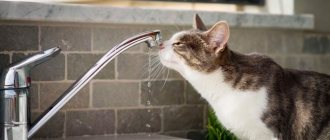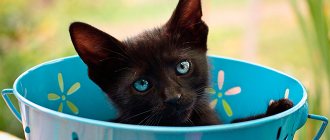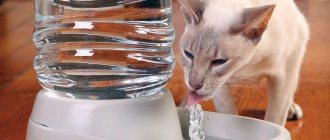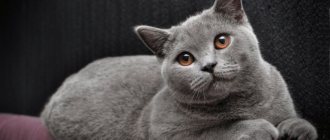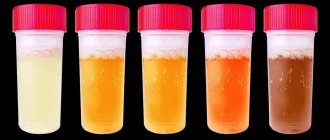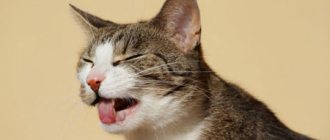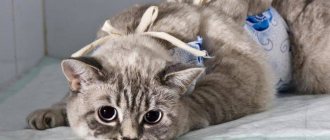What is it, basic information
You probably understand that this is the name of a phenomenon in which a cat urinates a lot and constantly, and the volumes of urine released are very large. Polyuria does not manifest itself without polydipsia (increased thirst), so in many cases veterinarians have to find out what the main pathology is in this tandem. The symptoms of polyuria are simple and understandable: the animal urinates frequently and a lot, and also shows an increased interest in drinking water. Since most cats live exclusively indoors, they all use the litter box. So it’s easy to notice that something is wrong: if the litter in the cat’s litter has to be changed almost a couple of times a day, something is probably wrong with the cat’s health.
In addition, the constant release of urine contributes to the disruption of water-salt metabolism, and the general condition of the animal can noticeably deteriorate. The hair in the “back regions” is constantly wet, the cat gives off a sharp and unpleasant odor, and he constantly licks himself.
Important! You must understand that the situations: “He urinates often, but little by little” and “He urinates relatively infrequently, but a lot” are completely different and indicate diametrically opposed problems! If you suspect something is wrong, be sure to keep an eye on your pet!
The average normal urine output per cat is within 28 ml/kg per day. Roughly speaking, one four-kilogram cat excretes about half a tea cup of urine per day. Of course, you don’t need to run after your pet with a beaker: if he suddenly starts “prescribing” two glasses, it will always be noticeable. If you can't leave the litter box empty (to make it easier to determine the volume), simply record the amount of water your cat drinks. In the case when he drinks a full bowl in a day, something is wrong with him.
Kidney diseases in cats
Kidney pathology in pets is divided into several types:
- spicy;
- chronic;
- congenital.
Hereditary pathologies include:
- renal amyloidosis;
- cystic degeneration of parenchyma;
- absence of one kidney;
- abnormal development of the urinary organ.
Late diagnosis of the disease, long-term latent pathology are the main causes of kidney failure; symptoms in cats can be vaguely expressed and interpreted as signs of another disorder.
Acute renal failure in cats. Veterinary clinic Bio-Vet.
A sick pet exhibits symptoms of kidney pathology:
- thirst;
- polyuria;
- dehydration;
- indigestion;
- vomit;
- weight loss;
- anemia;
- damage to teeth and gums;
- unpleasant odor coming from the mouth.
The cat's fur becomes dull, hangs in clumps, and falls out. The organ of vision often suffers, and the retina of the eye is exfoliated. The animal is diagnosed with high blood pressure. Nephritis is often accompanied by hyperthermia and the appearance of foci of pain, which are detected upon palpation in the kidney area. Urine is odorless, colorless, and the kidneys do not filter urine. Intoxication of the body is caused by increased levels of creatinine and urea. The animal vomits and ulcers form in the mouth.
Kidney failure
Chronic nephropathy ends in the development of severe kidney disease, or stage II-IV chronic renal failure. The reason for euthanizing a cat is signs of kidney failure, symptoms of failure of the urinary organ.
CRF indicates the accumulation of toxic products in the blood and impaired renal function. The pet is recommended symptomatic therapy, hemo- and peritoneal dialysis. There are several types of chronic renal failure:
- acute;
- chronic.
The owner has difficulty identifying impaired renal function at the initial stage of the disease. In severe cases, swelling appears on the abdomen and paws. The animal refuses to eat due to a large number of bleeding ulcers on the oral mucosa. Age-related sclerosis and death of kidney cells are an obstacle to the pet’s recovery.
The disease progresses after the use of medications: antibiotics, NSAIDs, corticosteroids, drugs containing magnesium. Frequent vomiting and diarrhea reduce blood pressure and impair the blood supply to the kidneys.
Jades
Severe pathology of the urinary organ is manifested by inflammation resulting from the influence of many factors.
Nephrites are divided into the following types:
- inflammation of the glomeruli;
- pathology of renal tissue and tubules.
The causes of acute nephritis are:
- infectious processes (viral, bacterial);
- poisoning;
- burns;
- skin inflammation;
- hypothermia;
- injuries.
In the acute phase of the pathological process, the animal develops:
- weakness;
- hyperthermia;
- shiver;
- loss of appetite;
- thirst;
- hypertension;
- swelling of the eyelids;
- reduction in the amount of urine excreted;
- the appearance of pus in the urine;
- strong unpleasant odor of urine.
The animal behaves restlessly; upon palpation, painful areas in the kidney area are detected. The chronic stage of the disease is manifested by the following symptoms:
- large amounts of urine excreted;
- constant thirst;
- pallor of the mucous membranes;
- swelling of the abdomen, eyelids, paws, genitals.
The temperature does not increase; upon palpation, the kidneys are firm but painless. If the disease is not diagnosed in time, cystitis or chronic renal failure develops. Acute necrosis occurs in the kidneys, irreversible changes appear that worsen the function of the urinary organ.
Main causes, therapy
In any case, a constant urge to urinate, as well as excessive urination, indicate the presence of some serious problems for which it is better to immediately contact a veterinarian. In some cases, an increase in the volume of fluid consumed and urine excreted can be physiological and short-term: for example, if your cat has eaten a lot of dry food and is simply thirsty. Of course, the duration of the phenomenon in this case is no more than a day. Since the veterinarian will not treat polyuria itself, but the disease that caused it, he needs to identify it.
Polyuria may be caused by glycosuria (high blood glucose). This condition occurs with diabetes mellitus. We can say that in this case, not primary, but secondary urine is released. A similar situation is observed with hyperthyroidism. Polyuria can also occur as a result of degenerative phenomena in the kidneys (nephrosis, amyloidosis), when the organ can no longer perform its filtration role normally. Let us remind you once again that in all these cases the animal drinks a lot of water, since the water-salt balance in its body is constantly disturbed.
How is the diagnosis made? Firstly, polyuria almost never acts as an independent disease. Its appearance is always caused by some other, serious destructive change in the animal’s body. Very often, diabetes mellitus and hyperthyroidism can lead to polyuria, which simultaneously cause severe thirst.
To identify the root cause, a full range of diagnostic tests will be required: urine, blood, tests for antidiuretic hormone, culture media in case of suspected infectious disease. Ultrasound and radiography are indicated, as it is important to determine the condition of the kidneys. As such, there is no specific treatment for polyuria in cats: first, the disease that caused it is treated. Diabetes mellitus, nephritis or nephrosis, problems with thyroid or hypothalamic hormones...
Diagnosis of polyuria in cats
To make a correct diagnosis, the doctor needs to conduct a set of diagnostic studies, since polyuria is not an independent disease, but one of the symptoms in the overall clinical picture.
Mandatory measures include a visual examination of the animal, palpation of the abdomen, asking the owner how often the cat pees, blood and urine tests, culture media (if an infection is suspected), and tests for the hormonal antidiuretic complex. To determine the condition of the kidneys, abdominal ultrasound and radiography are indicated.
In order to make a diagnosis, it is necessary to exclude the use of medications, increased salt intake, recent infusion therapy, and also determine the reproductive age of the animal.
Attention is paid to such signs as weight loss, impurities in the urine, and changes in the color of urine.
Sometimes, to determine the diagnosis, some diseases may require keeping the cat in the hospital all day. This need may be due to endocrinological tests (for diseases of the endocrine system).
Increased urinary volume in cats
Increased volume of urination, otherwise known as polyuria , is a common problem in small animal veterinary medicine. In animals, just like in humans, the organ that maintains water balance is the kidneys. Polyuria is the inability of the kidneys, for one reason or another, to retain water in the body.
The separation of large amounts of urine, as a rule, causes increased thirst ( polydipsia ) in the animal. We have the right to talk about polyuria only when the volume of urine excreted by an animal per day exceeds 50 ml/kg of animal weight, while, as a rule, the volume of liquid drunk by an animal per day exceeds 100 ml/kg of weight.
If polyuria is suspected, it is important for the owner to distinguish this condition from other problems, such as, for example, increased frequency of urination or urinary incontinence. To do this, the owner must study the behavior of his animal when urinating and drinking water. Sometimes the volume of fluid intake in animals can increase when switching to a dry diet or when the ambient temperature rises, and this will not lead to true polyuria. An increased volume of urination may occur when taking certain medications with a diuretic effect, as well as after giving your animal drip infusions of various solutions.
Most diseases that cause polyuria affect several body systems at once, so other problems may be present in the medical history. Polyuria is often accompanied by weakness, depression, loss of appetite and vomiting - these symptoms can be observed with chronic kidney diseases ( renal failure, pyelonephritis , etc.), with pyometra (purulent inflammation of the uterus) or other source of inflammation in the body, tumor processes , diabetes mellitus , central diabetes insipidus , liver diseases , Addison's disease (this is insufficiency of the adrenal cortex). Disease of the thyroid gland ( hyperthyroidism ) can also be accompanied by polyuria, and the animal experiences weight loss along with increased appetite. With Cushing's syndrome, along with polyuria, owners may notice the animal's lack of endurance to exercise (not to be confused with depression), weight gain, coat abnormalities, and increased appetite.
Finally, urine volume may increase secondary to a disturbance in the thirst control mechanism, in what is called primary psychogenic thirst . This may be associated with both a behavioral defect and pathology of brain structures.
Thus, if an animal urinates excessively, the doctor can suspect many diseases. For further diagnosis, the doctor will follow a specific examination algorithm.
Increased thirst (polydipsia) in animals - reasons, how to help?
Increased thirst (polydipsia) is the drinking of water in very large quantities.
The desire to drink plenty of water can be observed in animals with diseases such as peritonitis, intestinal obstruction and other pathologies that are accompanied by an increase in body temperature and often shortness of breath.
Daily water consumption and deviations from the norm
The need to drink is a normal state of a healthy body. Exactly how much water an animal can drink depends on the individual characteristics of the pet, as well as other important factors: humidity, physical activity, ambient temperature. On average, the drinking requirement of a healthy animal is from 20 to 70 ml/kg per day.
You should also take into account your pet’s diet: ready-made canned food can contain up to 70 percent liquid. Excessive (pathological) fluid consumption usually begins with water intake of more than 100 ml/kg per day. To make sure that your pet is suffering from increased thirst, an attentive owner should measure the amount of water he drinks over a 24-hour period, or better yet, a couple of days.
If the normal volume is indeed increased, you should immediately contact your veterinarian and find out the cause of such deviations. The kidneys, hypothalamus and pituitary gland are responsible for fluid intake and urine excretion. The main hormone regulating water metabolism is antidiuretic hormone (ADH) or vasopressin.
What diseases can be accompanied by increased thirst (polydipsia)?
Often increased thirst is provoked by active urine production (polyuria) as compensation to avoid dehydration. If, in addition to severe thirst, the animal exhibits increased appetite, it may be suffering from diabetes. Dogs may experience hyperadrenocorticism (sustained chronic increase in cortisol levels in the blood), and cats may experience hyperthyroidism (pathology of the endocrine system).
Decreased appetite, in turn, can be caused by purulent inflammation of the uterus. Severe thirst with poor appetite and weight loss is often caused by chronic kidney disease, liver disease, and hypercalcemia in oncology.
With very strong thirst - when the pet tries to get water from all available sources - the suspicion of diabetes insipidus or psychogenic polydipsia increases.
Other reasons may be high salt concentration in the body, taking certain medications, low protein diet, etc.
Where to go for diagnostics?
It is not difficult for a loving owner to understand when his pet is unwell. But it is impossible to find out what the cause of the disease is on your own. The only right decision in this case is to consult a veterinarian. Only a specialist will be able to conduct an initial examination, prescribe additional examinations (if necessary), based on which he will recommend the optimal treatment. Often, in order to find out the presence and degree of development of the disease, the veterinarian prescribes a general analysis of urine, blood, determination of thyroxine (more so in older cats), and an ultrasound of the internal organs.
In order to exclude hyperadrenocorticism, it is necessary to study the urine for the cortisol/creatinine ratio. The veterinary diagnostic clinic “Friend” is happy to help you discover the cause of your pet’s illness and select comprehensive methods to combat the disease so that your pet will soon delight you with its excellent health!
Polyuria in dogs and cats
Polyuria
– increased volume of urination, in which
the urine
has a low relative density, is almost colorless and is always accompanied by increased water consumption (polydipsia). The kidneys play a crucial role in this process, being a regulator of the body’s water-salt balance. Polyuria and polydipsia are indicators of water-salt imbalance in the body.
Polyuria is divided into two types: physiological and pathological.
Physiological polyuria occurs with increased physical activity, stress, feeding only dry food, increased salt content in the food, increased ambient temperature, when the animal begins to consume more fluid, giving diuretics or intravenous drip infusion. In this case, we are not talking about pathology. Moreover, frequent urination (pollakiuria) and urinary incontinence
do not talk about true polyuria. And in pregnant females and animals in the heat stage, frequent urination is normal. However, frequent urination is common in patients with lower urinary tract disease and is often a sign of irritation of the bladder wall due to inflammation, irritation from urine, salt crystals and bacterial flora.
Pathological polyuria, on the contrary, can occur as a consequence of certain pathological processes:
- chronic kidney disease ( renal failure
, nephritis,
pyelonephritis
, etc.) - liver diseases - inflammatory processes of internal organs (purulent inflammation of the uterus (
pyometra
), peritonitis, etc.) - diabetes mellitus - diabetes insipidus -
Cushing's syndrome
(hyperthyroidism) -
Addison's disease
(adrenal cortex insufficiency) - disorder functions of the thyroid gland - tumor processes - disruption of the thirst center in the brain - increased calcium levels in the blood serum
Polyuria may be accompanied by lethargy, decreased appetite and activity, and changes in body temperature (increase or decrease). Polyuria is compensatory and is often an indicator of systemic disease.
Common causes of polyuria in cats are kidney disease and diabetes.
and hyperthyroidism. Dogs have kidney disease, diabetes mellitus and hyperadrenocorticism.
Moreover, if we talk about true polyuria, the amount of fluid consumed per day, as a rule, is more than 100 ml/kg of animal weight, and the amount of urine excreted exceeds 50 ml/kg of weight.
The information provided by the owner to the doctor plays a very important role in making a diagnosis, since it is the owner who has the opportunity most of the time to observe changes in the behavior and health of his pet. The owner needs to pay attention to the volume of fluid consumed and urinated, since changes in the volume of fluid consumed and excreted may indicate the first signs of serious systemic diseases.
To the general practitioner
It is necessary to provide information regarding the volume of fluid consumed by the animal per day and the amount of urine excreted as a result. Next, the general practitioner will collect a detailed medical history of the patient’s life, which will make it possible to make a preliminary diagnosis and, if necessary, resort to additional diagnostic methods (general urine analysis with determination of its specific gravity and glucose content, blood tests, ultrasound of the abdominal cavity, etc.) .
Successful treatment of polyuria and polydipsia depends on correct identification of the etiology. Early detection is key to initiating treatment, which can not only slow the progression of the disease, but also potentially prevent the development of serious complications.
Chronic kidney disease in dogs and cats can be treated with a special diet and, if necessary, fluid therapy. Serial monitoring of urine samples in patients with diabetes mellitus and other chronic kidney disease will help avoid the occurrence of secondary bacterial infection with subsequent pyelonephritis and prevent the development of episodes of acute renal failure. Diabetes mellitus in cats can be effectively managed through diet when the disease is diagnosed before insulin dependence begins. Such common diseases of the endocrine system as hyperthyroidism and hyperadrenocorticism can be corrected with the help of certain medications. Early recognition, appropriate home monitoring, and treatment of insulin-dependent diabetes mellitus in dogs and cats can help circumvent the development of life-threatening ketoacidosis.
Early diagnosis of chronic diseases avoids unnecessary stress for owners and the development of chronic diseases in their pets.
Early diagnosis and treatment of chronic diseases associated with polyuria and polydipsia will ensure that your pets live fuller, healthier lives.
Physiological, with pathological polyuria
There are 2 types of disease. Polyuria can be physiological or pathological. Type 1 occurs when the animal:
- receives large physical loads;
- exposed to stress;
- eats only dry food with excess salt;
- lives in a region with a hot climate or the room where the animal lives is too hot and because of this it drinks a lot of water.
If your pet is given a diuretic or intravenous drip infusions and it urinates frequently, this is not a pathology. Frequent urination or fluid incontinence may also indicate other diseases, such as cystitis. Pregnant women or females in heat often urinate and this is within normal limits.
But frequent urination should alert the owner. It may be a sign of inflammation of the urinary tract due to a large number of bacteria.
With pathological polyuria, the following processes can occur in the body:
- advanced kidney disease: pyelonephritis, with renal failure or nephritis;
- liver diseases;
- an abscess in the internal organs, for example, pyometra in the uterus, peritonitis or something else;
- disorders of the thyroid gland;
- diabetes insipidus;
- diabetes;
- adrenal insufficiency or Addison's disease;
- hyperthyroidism or Cushing's syndrome;
- neoplasms;
- there is too much calcium in the blood serum;
- there is some kind of pathology in the brain, in the center of thirst.
With polyuria, your pet may experience:
- poor appetite;
- low mobility;
- lethargy;
- body temperature rises or falls.
Polyuria is compensatory and is often an indicator of systemic disease.
What to do if your cat has frequent urination: causes and treatment
The symptom of frequent urination (pollakiuria) in cats almost always indicates health problems, some of which can be easily corrected and treated, but there are others that lead to the death of the animal. If you notice that your cat is peeing frequently , and the norm is to urinate up to three times a day, then you need to urgently pick up the phone and seek advice from a veterinarian. It is worth knowing what reasons are hidden behind the cat’s frequent trips to the toilet and providing timely help to the animal.
More than half of all cats are mature cats, meaning they are eight years or older. The owners of such cats need to understand all the subtleties and features of the health of their pets. Older cats, more than anyone, need regular veterinary examinations and constant checks. It is quite natural for adult cats to consume more water, but spontaneous, strong thirst can be an important symptom that indicates one or another, but still serious, health problem in a domestic cat.
Causes of extreme thirst in cats.
Cats are prone to several diseases that are similar to human diseases, namely at a fairly old age. The most common human diseases such as diabetes, kidney disease, heart disease and cancer are precisely those considered to be diseases. These are diseases of mature cats, therefore, young cats are less susceptible to them. And sometimes such diseases turn out to be the causes of severe thirst in cats. And now more details.
Diabetes mellitus in cats.
Just like in humans, there are two types of diabetes in cats. These are stage 1 diabetes and stage 2 diabetes. If stage 1 diabetes is primarily caused by a lack of insulin or insufficient production, then stage 2 diabetes develops as a result of the insufficient ability of body cells to use the available supply of insulin. Of course, diabetes can strike a cat at any age, but older cats are more susceptible to this disease. The main symptoms of diabetes in cats are lack of appetite, vomiting, emaciation, atypical skin and coat, shortness of breath, lethargy, dehydration and, of course, extreme thirst. If such symptoms are detected, you should seek help from a veterinarian and begin the treatment process immediately.
Fatty hepatosis.
This disease develops as a result of the spontaneous formation in the middle of the liver of a large number of fat cells, which the cat’s body is not able to cope with. The clear cause of this disease is not yet known to doctors and the disease is diagnosed only by the results of a biopsy. Symptoms of fatty liver disease include a sudden decrease in appetite and weight loss, accompanied by extreme thirst. Other symptoms are also observed, which include: apathy, vomiting, bloating. If such symptoms are detected, it is necessary to take the animal to a veterinarian for examination.
Chronic renal failure.
The differences between chronic kidney failure and acute kidney failure are very minimal. Chronic renal failure is the most common cause of death in adult cats. Unfortunately, this is an irreversible and long-term destruction of kidney tissue and cessation of their basic functions. Extreme thirst in this type of disease is characterized by several other symptoms, including weight loss, loss of normal appetite, problems with urination, nausea, vomiting and an unhealthy coat. The course of treatment includes proper nutrition, the use of appetite stimulants and certain medications aimed at combating the disease.
Severe thirst can sometimes be caused by other ailments: polyuria, hyperthyroidism, hypertension, polydipsia. There is no need to neglect any significant changes in your cat’s behavior, as this may be the very beginning of the manifestation of a terrible disease.
0
The cat pees often: treatment
In this case, it is not necessary to treat the symptom itself, but to look for the original source of the problem and deal directly with its elimination.
What will help your pet get rid of frequent urination should be decided by your tandem with the treating veterinarian; without a doctor you will not make the correct diagnosis and will lose valuable time.
- If you contact a veterinarian with this problem, he may prescribe the following tests and examinations:
If a cat is diagnosed with cystitis, the doctor will prescribe a course of antibiotics, bladder lavage, antispasmodics, and a diuretic.
If a cat is diagnosed with urolithiasis, then it is necessary to ensure the free flow of urine, for which a catheter is inserted under general anesthesia. Surgery to remove bladder stones and intensive symptomatic treatment are often required. Under no circumstances should you try to treat this disease yourself, as only specialists will save your furry pet from death!
If your pet has diabetes, doctors will determine what type it is and prescribe appropriate treatment. You may need to inject your cat with insulin. If you have type 2 diabetes, which is insulin-independent, a special diet, weight loss for obesity, and medications to improve pancreatic function will help.
If the cat is simply marking its territory, then this condition does not require special treatment, since it is not pathological. You may choose to have the animal neutered, after which the behavior usually goes away.
If the cause of frequent urination is stress, try to eliminate its cause. However, to make sure that the animal is truly healthy, take it to the vet.
Diagnostics
To eliminate the above problems, an animal with polydipsia undergoes a full range of tests within the walls of a veterinary clinic. Research includes:
- Taking an anamnesis, interviewing the owner, examining the animal, palpation of the abdomen, palpation of the thyroid gland.
- Clinical blood test - to assess the cellular composition of the blood, to exclude the presence of acute inflammation.
- Biochemical blood test - to assess the functioning of the kidneys and liver, to assess the electrolyte composition of the blood, to exclude hypercalcemia.
- Measuring glucose levels with a glucometer - to exclude possible diabetes.
- Urinalysis - to assess the specific gravity of urine, exclude glucosuria, proteinuria, and inflammation.
- Ultrasound of the abdominal cavity - to exclude pyometra, to assess the structure of the kidneys and liver.
- Assessment of parathyroid hormone levels.
- To exclude hyperadrenocorticism, a small and large dexamethasone test, the ratio of cortisol and creatinine in the urine, and measurement of the concentration of adrenocorticotropin in the blood.
Prevention of diseases of the genitourinary system, the cat often pees
Every owner needs to know the basic measures to prevent urinary problems in their furry cat.
If your animal is at risk for any reason (age, belonging to a certain breed, past illnesses and surgeries, gender), then it is worth regularly conducting routine examinations with a veterinarian, which will allow you to diagnose ailments at their onset.
Consult with a veterinarian about the composition and quantity of your pet’s food, adequate drinking regimen, and nutritional features of neutered cats. The domestic cat's menu should be replenished with high-quality food and water.
Make sure your kitten and adult cat are vaccinated regularly. The stronger the animal’s immunity, the fewer problems there will be with the genitourinary system and the general condition of the body.
Protect cats prone to cystitis from hypothermia on a cold surface and provide rest in a place protected from drafts on a warm bedding. This will help prevent your cat from peeing frequently.
In conclusion, I would like to say that many diseases of the urinary system in the early stages are successfully and quickly cured. If the disease is chronic, regular monitoring by a veterinarian will help avoid its complications and relapses. The veterinary center “I am VET” employs specialists who deal with more than 150 different pathologies in their practice. We have gained successful experience in on-site veterinary care, where almost any service and treatment can be easily provided at home in compliance with all the conditions of a veterinary clinic.
In this case, the animal will recover faster in a familiar environment, and the owner will save his time and effort. Of course, for severe patients there is a hospital with all the necessary equipment. You can get a free consultation, arrange a doctor’s call, find out prices for services and veterinary drugs by calling our center. We work for you around the clock, 365 days a year!
Causes of the disease
Urine excretion is a necessary physiological process through which waste and toxins are eliminated from the body. A pathological condition in which a cat pees more often than usual indicates a malfunction of the urinary system and is called pollakiuria in veterinary medicine.
This term refers to excessively frequent urine output that goes beyond the cat’s daily norm while maintaining a normal volume. Pollakiuria is not an independent disease, but a harbinger of diseases of various organs and systems.
Pathological causes of frequent urination include:
- cystitis;
- urolithiasis disease;
- diabetes;
- urinary tract infections;
- renal and liver failure;
- prostatitis;
- bakvaginitis (in cats);
- malignant and benign tumors, due to which compression of the bladder occurs and its mechanical emptying;
- central diabetes insipidus;
- purulent inflammation of the uterus (pyometra);
- hyperthyroidism;
- Cushing's syndrome;
- kidney pathologies (nephrosis, amyloidosis);
- urinary incontinence;
- Addison's disease.
Often, a cat pees more often than usual due to stressful situations that he has had to endure.
A change of place of residence, the appearance of another pet in the house, noisy companies, and even a regular car trip to the veterinary clinic can negatively affect the animal’s psyche and lead to a reflex contraction of the bladder. When the cat calms down, he will go to the litter box as before.
Another factor in portioned urination is when cats reach a certain age when they begin to become sexually active. Leaving marks is normal and has nothing to do with illness. Thus, the cat shows that he is the master of his territory.
Other signs that can cause urine leakage include old age, extreme thirst, hypothermia, and taking certain medications (anticonvulsants, cortisone, diuretics, etc.).
Causes of polyuria in cats
As mentioned above, the causes of frequent urination in cats can be either behavioral or pathological.
Increased urination of a physiological nature is caused by:
- Mating time. At a certain period, animals of both sexes begin to mark their territory. The marks have a peculiar unpleasant odor with a small amount of urine. Their behavior changes: they become restless, scream loudly, and twitch their tail.
- Stress. The nervous shock that an animal may experience, for example, during a move, leads to a reflex contraction of the bladder.
- Elderly age. One of the signs of old age is a weakening of the bladder.
- Intense thirst. However, if your cat drinks a lot and is losing weight rapidly, he should be tested for diabetes.
- Hypothermia. If a cat is very cold, then increased urination is normal for her. If the symptom does not go away after some time, it means that bacterial infections have begun to develop in the body.
- Taking certain medications, such as diuretins, cortisone, anticonvulsants.
Pathological reasons indicating the presence of a disease in the body:
- Urinary tract infections. If a bacterial environment is added to the infection, then in addition to frequent urine output, the cat experiences pain and pain during the process of urination. Urine may contain a small amount of blood.
- Kidney failure, accompanied by symptoms such as vomiting, low body temperature, weakness, and lack of appetite.
- Liver failure.
- Urolithiasis disease. Sand and stones formed in the organs, moving, lead to sharp pain when urinating. Micro-wounds and irritations appear in the mucous lining of the urinary tract. There may be blood and sediment in the urine. The animal urinates frequently, but the urine portions are small.
- The formation of tumors that mechanically compress the bladder and lead to its emptying.
- Backvaginitis (in cats). The disease is accompanied by yellow, green discharge, an unpleasant odor and the habit of licking the genitals.
- Prostatitis (in cats). The enlarged prostate puts pressure on the intestines and ureters. The pathology is accompanied by fever, constipation, and frequent painful urination.
- Central diabetes insipidus.
- Degenerative changes in the kidneys (amyloidosis, nephrosis), in which the paired organ can no longer perform its filtration function normally.
- Pyometra (purulent inflammation of the uterus in cats).
- Hyperthyroidism (changes in hormonal levels).
- Cushing's syndrome.
- Addison's disease (adrenal insufficiency).
INTERESTING TO KNOW: Symptoms of worms in cats and their types
If a cat has symptoms that are not associated with the physiological factor in the development of polyuria, you should show the animal to a veterinarian without wasting precious time. Kidney diseases are very dangerous and difficult to treat.
Main symptoms
Signs of urinary dysfunction are visible to the naked eye: the cat pees more often than usual. If the volume of daily urine output is exceeded, then we are no longer talking about pollakiuria, but about polyuria. This can be understood by the litter in the cat's litter box.
For example, if you used to change it once a week, and recently - 2-3 times a week, it means that a serious failure has occurred in the cat’s body. For reference: the normal volume of urine excreted in an adult cat is on average 28 ml (about half a tea cup) for 2-3 visits to the litter tray per day.
Frequent urination may be accompanied by other signs - increased thirst, discharge of blood and pus along with urine, fever, weight loss. Due to frequent urination, the water-salt balance is disturbed and the appearance of the pet worsens.
The fur on the hind legs, belly, and lower part of the tail is constantly wet, emitting an unpleasant odor. For cats, which are naturally very clean animals, this causes considerable discomfort, forcing them to constantly lick themselves.
It is worth observing the cat's condition. Perhaps the dry food is too salty or she has eaten too much of it. If pollakiuria is associated specifically with the diet, then within a day urination will normalize.
Symptoms
Signs of polyuria are visible to the naked eye: the animal urinates a lot and often. Many owners may immediately ask the question: “How much is a lot?” On average, a cat's urine output per day corresponds to approximately half a tea cup (28 ml).
But how can we determine this? After all, you won’t run after an animal with a beaker. The easiest way to determine this is by looking at the tray. If, for example, not so long ago the contents of the cat litter had to be changed once a week, then with polyuria - almost twice a day.
The second obvious sign is increased thirst. If your cat drinks a full bowl of water a day, something is wrong with him.
The constant release of urine leads to an imbalance in the water-salt balance, which affects the cat’s health. Its appearance also deteriorates: the fur on the hind legs and lower part of the tail is constantly wet, emitting a strong unpleasant odor, as a result of which the animal licks itself more often than usual.
It is worth considering that if a cat pees often, then perhaps your pet simply ate too much dry food, as a result of which he became thirsty, and accordingly, he will go to the toilet more often. This phenomenon will last no more than a day, after which the animal’s urination will return to normal.
But if this happens to a cat systematically, then you should immediately contact a veterinarian - the pet has obvious health problems. In this case, the specialist will not treat polyuria as such, but the disease that caused it, because increased urination is only a symptom.
INTERESTING TO KNOW: What to do if a cat’s eye is cloudy
It should be noted that if a cat urinates frequently, but in small portions, then we are not talking about polyuria, which is characterized by large portions of urine, but about the opposite phenomenon - pollakiuria.
Diagnostics in a veterinary clinic
To make a correct diagnosis, a veterinarian needs to conduct the necessary diagnostic tests. After a visual examination of the animal and collection of anamnesis, the specialist prescribes for the cat:
- blood and urine tests;
- Ultrasound of the kidneys, bladder, abdominal cavity;
- radiography;
- seeding on nutrient media (in case of possible bacterial infection);
- studies on the hormonal antidiuretic complex.
When conducting diagnostics, the veterinarian excludes factors such as increased salt intake, medications, and infusion therapy.
Symptomatic treatment
If nothing has changed in the cat’s life, and she suddenly begins to drink too much, and her condition worsens, the animal should be shown to a doctor.
The veterinarian will determine the cause of the cat's pathological thirst. To do this, the specialist will conduct an external examination, collect anamnesis, and prescribe various examinations (blood and urine tests, ultrasound, computed tomography, etc.).
In addition, to make a correct diagnosis, it makes sense to analyze the combination of symptoms. The most common conditions are:
- The cat constantly drinks a lot, but does not eat anything. This condition can be caused by fever, intoxication, disturbances in the digestive system, wounds and damage to the oral cavity, pyometra and oncology.
- The cat urinates frequently and drinks a lot. This happens with kidney failure, diabetes, and liver problems.
- An elderly cat drinks a lot. In this case, the cat may have problems with the kidneys or liver, metabolic disorders, malignant neoplasms, dehydration, elevated body temperature, impaired absorption of fluids due to errors in nutrition or internal diseases.
Based on the data received, the veterinarian will make a diagnosis and prescribe treatment. It is important to strictly follow the recommendations and not self-medicate. Sometimes it can be very difficult to “give” a cat medicine. In this case, experts recommend wrapping the animal in a diaper or towel, opening its mouth and injecting the medicine using a syringe without a needle. In this case, you need to wait until the cat swallows the entire portion, and not let it go ahead of time, even if the cat tries to break free.
Treatment method and prognosis
There is no single treatment regimen for pollakiuria. Therapeutic procedures are prescribed after diagnosis. As mentioned above, pollakiuria can be a sign of a dangerous disease, so treatment will be aimed at eliminating it.
Thus, for diabetes mellitus, insulin therapy is an important stage of treatment. With the help of drip infusion of polyionic drugs, the water-salt balance is restored. The key to successful treatment and recovery or maintaining quality of life at a satisfactory level is nutritional correction and quality care.
It often happens that the pet will be limited in physical activity for the rest of its life, take appropriate medications and eat exclusively special medicinal food.
If pollakiuria is caused by stress, then, first of all, it is necessary to eliminate the source of psycho-emotional stress. To reduce the negative effects of stress, your veterinarian may prescribe anti-anxiety medications, such as Stop-Stress.
Cat marks are an unpleasant phenomenon, but an animal cannot be punished for it. The best way out would be castration or the sedative phytohormonal remedy Kot Bayun.
Antispasmodics are indicated to relieve pain; antibiotics and sulfa drugs are used to eliminate infections.
The prognosis for pollakiuria again depends on the underlying disease. If, for example, we are talking about an infection, then one course of antibiotic therapy is enough. But with malignant and benign diseases, veterinarians are no longer so optimistic in their forecasts.
What to do at home
The pet owner must follow the veterinarian's instructions. Self-medication is dangerous to health! Uncontrolled use of drugs or replacement of conservative treatment with folk remedies can cause irreparable harm to the cat’s health.
A sick furry cat should be provided with good care and adequate nutrition. It would also be useful to take vitamins, which are also prescribed by a specialist.
Prevention measures
Any disease can be prevented using the simplest preventive measures that are known to every experienced cat owner:
- water quality control (bottled, filtered, not raw tap water);
- reasonable physical activity - sedentary animals are more susceptible to pathologies of the urinary system;
- preventing the development of obesity;
- balanced diet enriched with nutrients;
- regular preventive examinations at the veterinarian, allowing to identify the disease at the initial stage;
- avoiding hypothermia.
To prevent diseases of the genitourinary system, it is recommended to give your cat the herbal preparation KotErvin 2 times a year.
Urgent causes for concern:
Hypoglycemia (low blood glucose) is the most serious life-threatening complication that can occur at home. Hypoglycemia can occur if too high a dose of insulin is received or if the insulin administration regimen is disrupted. Main symptoms:
Weakness/lethargy
Disorientation
"Drunk gait" - impaired coordination of movements
Strange behavior: walking aimlessly, licking lips, searching for food
Neurological symptoms: collapse, convulsions, loss of consciousness, and ultimately death.
If these symptoms appear, hypoglycemia must be confirmed by glucometry and the animal must be offered glucose syrup, honey, sugar, and be sure to consult a doctor, as intravenous administration of glucose may be required.
Ketoacidosis is an uncommon complication of poorly controlled diabetes. It can cause rapid death if left untreated and therefore requires immediate action when suspected. Clinical symptoms:
-Loss of appetite
-Lethargy/weakness
-Vomiting/diarrhea
-Dehydration/collapse
-Breath may have a fruity odor
Cats suffering from ketoacidosis require immediate intensive treatment with insulin to control diabetes, intravenous fluids, antibiotics and bicarbonate. It is important to contact your veterinarian immediately.
Initially, all cats with diabetes should be seen every one to two weeks to assess diabetes control and be weighed. In well-controlled diabetes, less frequent monitoring may be sufficient, although this should not be done less than every 3-6 months.
